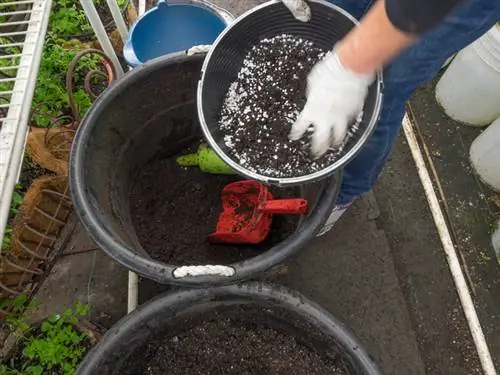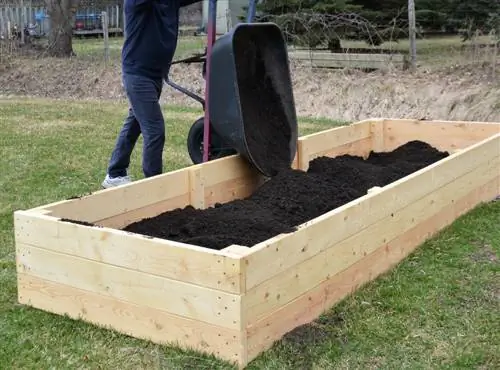- Author admin [email protected].
- Public 2023-12-16 16:46.
- Last modified 2025-01-23 11:21.
Especially when you are creating your first greenhouse floor, it is important that the soil's nutrient content is balanced. A structure that is as crumbly as possible not only stimulates plant growth, but also makes correct planting and regular soil care much easier.

How do I properly prepare the soil in my greenhouse?
To optimally create a greenhouse soil, it should have a pH value of 6-7, sandy loam soil and a balanced nutrient content (15-25 mg phosphate, 15-25 mg potassium oxide, 10-15 mg magnesium per 100 g of dry soil). Organic fertilization and regular soil analysis are recommended.
The basis for he althy and productive growth of your greenhouse plants, especially vegetables and herbs, is fertile soil that also has a deep pH value between 6 and 7. A slightly sandy loam soil is well suited, the humus content of which can be slightly higher, especially when growing young plants. If it's sifted and the structure is too fine, plants don't like it that much, thenit's rather crumbly, which in turn is good for strong rooting.
A balanced nutrient content is mandatory
The exact values when creating a new greenhouse floor always depend on the type of planting. They also don't have to be general for the entire area if your greenhouse is divided into different zones and beds. The recommended guideline values with regard to nutrient content are based on 100 grams of dry soil for:
- Phosphate: 15 to 25 mg
- Potassium oxide: 15 to 25 mg
- Magnesium: 10 to 15 mg
If you want to manage your greenhouse professionally and value he althy growing vegetable crops, you should have your current soil conditions checked in a laboratory and repeat the analysis every four to five years.
Also fertilize the greenhouse soil regularly organically
Garden compost, one of the best organic fertilizers ever, is also ideal for improving soil fertility in the greenhouse. However, it should befree of weed seeds if possible. If the compost you make yourself does not contain the required nutrients, you will have to use commercial fertilizer (€12.00 on Amazon). How large the proportion of compost is in the entire greenhouse floor depends on whether low, medium or even heavy feeders are to be grown. The table shows some examples:
Heavy to light feeders of vegetable crops and herbs
| Nutrient requirements | Vegetables | Types of herbs |
|---|---|---|
| Low | Peas, radishes, lamb's lettuce, bush beans, chicory | Spoonwort, chervil, caraway, oregano, wormwood, thyme |
| Medium | Carrots, lettuce, peppers, asparagus, onions, spinach | Parsley, chives, sage, tarragon, savory, dill |
| High | Kale, savoy cabbage, leek, zucchini, eggplant, potatoes |
Do you fertilize minerally or organically?
Especially when creating new greenhouse soil, it is advisable to give preference to organic fertilization. However, it does not work immediately in the soil, as the components first have tobe slowly broken down in the soil in order to be available to the plants. For plants with a longer cultivation period, fertilizer doses can be staggered into the soil. Mineral fertilizers help faster and especially when there is an acute nutrient deficiency. They are best added to the soil together with irrigation water.
Tip
Stable manure as fertilizer is not needed for the nutrient cycle in the greenhouse. Studies have often confirmed that the introduction of manure literally over-fertilized many vegetable gardens, which has an unfavorable effect on plants and soil.






